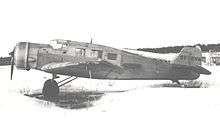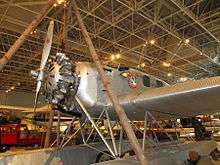Junkers W 34
| W 34 | |
|---|---|
 | |
| Canadian Airways CF-ARI | |
| Role | Transport |
| Manufacturer | Junkers |
| Designer | Herman Pohlman[1] |
| Introduction | 1926 |
| Developed from | Junkers W 33 |
| Developed into | Junkers Ju 46 |
The Junkers W 34 was a German-built, single-engine, passenger and transport aircraft. Developed in the 1920s, it was taken into service in 1926. The passenger version could take a pilot and five passengers. The aircraft was developed from the Junkers W 33. Further development led to the Junkers Ju 46.
Production and service
One Junkers W 34 be/b3e managed to break the then current altitude record on May 26, 1929 when it reached 12,739 meters (41,795 feet). That aircraft carried the markings D-1119 and it was equipped with a Bristol Jupiter VII engine. The airplane was flown by Friedrich W. Neuenhofen.

The Junkers W 34 was manufactured in many different versions. The total production numbers for the civil market were around 1,000, a further 2,024 his and haus were built under license for the RLM and Luftwaffe. The unit price was between RM 65,000 and 70,400.
On January 31, 1944, the Luftwaffe still had 618 W 34hi's and 516 W 34haus in service: the majority were used by flight schools.
The Junkers K.43, nicknamed the "Bush Bomber", was used extensively during the Chaco War (1932–1935) fought between Bolivia and Paraguay. See external links.
The Colombian Air Force used the W 34 and K-43 in the Colombia-Peru War in 1932–3.[2]
The Swedish Air Force operated three W 33/34 between 1933 and 1953 in the transport and air ambulance roles, initially with the military designation Trp 2 and Trp 2A, eventually changed to Tp 2 and Tp 2A. One of these are preserved today in civilian colours as SE-BYA.
Production
- W 34 hi
- Junkers (105 aircraft built), Henschel (430), ATG (94), Dornier Wismar (58), HFB (69) and Weser (221).
- W 34 hau
- Henschel (329), Arado Brandenburg (205), ATG (105), Dornier Wismar (93), HFB (192) and MIAG Braunschweig (73).
Versions
- W 34 a
- 331 kW Gnome et Rhône 9A Jupiter engine, speed: 190 km/h, wingspan: 17.75 m and length 11.10 m
- W 34 be
- 375 kW Gnome et Rhône 9A Jupiter engine, speed: 230 km/h, wingspan: 17.75 m, length: 10.70 m
- W 34 be/b3e
- 441 kW Bristol Jupiter VII engine and was used for attempts to try breaking the world altitude record
- W 34 ci
- 405 kW Pratt & Whitney Hornet engine, speed: 245 km/h, equipped with cabin windows
- W 34 di
- like the W 34 ci, the engine was license produced by BMW.
- W 34 f
- 331 kW Gnome et Rhône 9A Jupiter engine, speed 190 km/h, wingspan 18.48 m, length 11.10 m, enclosed cockpit, ailerons were lengthened; the export version had a cargo door
- W 34 f
- experimental aircraft with floats
- W 34 fa
- passenger aircraft for export
- W 34 fä
- export aircraft
- W 34 fo
- export aircraft with a Pratt & Whitney R-1340 engine
- W 34 fy
- Armstrong Siddeley Panther engine
- W 34 fao
- 397 kW Siemens Sh 20 engine, only one was produced for tests with autopilot
- W 34 fei
- 441 kW Siemens Sh 20 U engine, only one was produced as a maritime test aircraft
- W 34 fg
- Armstrong Siddeley Jaguar Major engine
- W 34 fue
- Pratt & Whitney Hornet engine, later rebuilt as a maritime aircraft.
- W 34 fi
- Pratt & Whitney or BMW built 405 kW Hornet; wingspan: 18.48 m, length 10.27 m, speed 260 km/h. The aircraft had an enclosed cockpit and low-pressure tires.
- W 34 gi
- 405 kW BMW Hornet, only one machine was produced in 1933 for tests
- W 34 hi
- 485 kW BMW 132A/E, the aircraft could take six passengers and was equipped with improved radio- and direction finders. This version was mostly used by Luftwaffe to train pilots and radio operators.
- W 34 hau
- similar to hi, but it had a 526 kW Bramo 322 H engine. The type was mostly used by Luftwaffe to train its pilots and radio operators.
- K 43
- Military W34, available in many of the above-mentioned versions.
Operators

- Argentine Air Force
- Argentine Naval Aviation - 1 W34 purchased in 1934, used as trainer [3]
- Guinea Airways
- Royal Australian Air Force
- Portuguese Army Aviation (Aeronáutica Militar) operated W 34L aircraft.
- Forças Aéreas da Armada operated K 43W aircraft.
- South African Airways operated 2 aircraft.
- South African Air Force
Accidents and incidents
- 3 May 1934: a Syndicato Condor Junkers W-34, registration PP-CAR, crashed on landing at Rio de Janeiro, Brazil. Two crew members died. The plane was repaired and later suffered a second accident in 1944.[5]
- 24 February 1942: a Syndicato Condor Junkers W-34, registration P-BAOA/PP-CAO, crashed while attempting an emergency landing at Riachão, Maranhão. Two crew members died.[5]
- 16 April 1944: PP-CAR, the same Junkers W-34 involved in the 1934 accident, this time operating for Cruzeiro do Sul, crashed during an emergency landing at Rio de Janeiro Santos Dumont Airport. Two crew members died.[5]
Specifications (W 34hi landplane)
General characteristics
- Crew: 8: pilot, co-pilot, 6 passengers
- Length: 10.27 m (33 ft 8¼ in)
- Wingspan: 17.75 m (58 ft 2¾ in)
- Height: 3.53 m (11 ft 7 in)
- Wing area: 43.0 m² (462.8 ft²)
- Empty weight: 1,700 kg (3,748 lb)
- Loaded weight: 3,200 kg (7,056 lb)
- Powerplant: 1 × BMW 132 radial engine, 660 hp (492 kW)
Performance
- Maximum speed: 265 km/h (143 knots, 165 mph)
- Cruise speed: 233 km/h (126 knots, 145 mph)
- Range: 900 km (487 NM, 560 mi)
- Service ceiling: 6,300 m (20,670 ft)
- Climb to 1,000 m (3,300 ft): 3.2 min
Armament
- 2x 7.92 mm machine guns (dorsal) and 1x 7.92 mm machine gun (ventral)
- 6x 50 kg bombs (300Kg total)
References
Notes
- ↑ Zoeller, Horst. "Junkers – Who is Who?". Archived from the original on October 27, 2009. Retrieved 2016-06-22.
- ↑ von Rauch 1984, pp.3–4.
- ↑ Histarmar - AVIONES DE ENTRENAMIENTO DE LA AVIACION NAVAL - JUNKERS W-34 (in Spanish) (accessed 2015-01-27)
- ↑ Grant 2004, pp.70–75.
- 1 2 3 Pereira, Aldo (1987). Breve história da aviação comercial brasileira (in Portuguese). Rio de Janeiro: Europa Empresa Gráfica e Editora. p. 131.
- ↑ Smith and Kay 1990, p.356
- ↑ Wagner and Novarra, pp.185–186
Bibliography
- Grant, Robert S. "Metal Marvels: Junkers W33s and W34s in the Canadian Bush". Air Enthusiast Number 110, March/April 2004. Stamford Lincs, UK:Key Publishing. ISSN 0143-5450. pp. 70–75.
- von Rauch, Georg. "A South American Air War...The Leticia Conflict". Air Enthusiast Number 26, December 1984–March 1985. Bromley Kent UK: Pilot Press. ISSN 0143-5450. pp. 1–8.
- Smith,J.R. and Kay, Antony. German Aircraft of the Second World War. London:Putnam, 1990. ISBN 0-85177-836-4.
- Wagner, Ray and Novarra, Heinz. German Combat Aircraft New York:Doubleday, 1971. ASIN B001PIB8NE.
Further reading
- Cicalesi, Juan Carlos; Rivas, Santiago (2009). Núñez Padin, Jorge Felix, ed. Junkers F13 / W34 / K43 / Ju52. Serie en Argentina (in Spanish). 3. Bahía Blanca, Argentina: Fuerzas Aeronavales. ISBN 978-987-20557-7-6. Retrieved 2015-01-27.
External links
| Wikimedia Commons has media related to Junkers W 34. |
- History of Bolivian Junkers K.43's use during fighting over the Gran Chaco area.
- Warbirds Resource Group-Luftwaffe Resource Center - Junkers Ju W34
- "Flyers Of The Sea", October 1931, Popular Mechanics